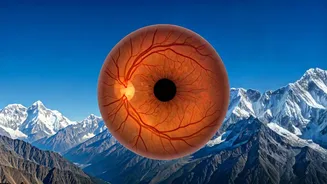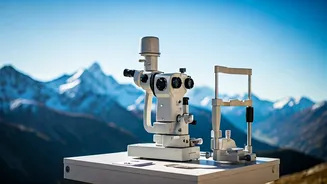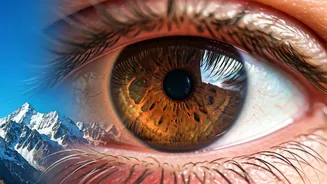Vision Loss Explained
High Altitude Retinopathy (HAR) is a condition that can result in sudden vision loss for individuals venturing into high-altitude environments. This occurs
due to physiological changes induced by the decreased oxygen levels at higher elevations. The retinal blood vessels become compromised, which potentially leads to swelling or bleeding in the retina. This, in turn, affects the hiker's ability to see clearly. The severity of the condition can vary widely, with some experiencing temporary blurring, while others face a more severe and lasting impact on their vision. It underscores the critical need for awareness and preparedness for anyone planning to trek or hike at high altitudes. Hikers must recognize the symptoms to ensure their safety and well-being in these challenging environments.
How Common Is It?
HAR isn't the most frequent ailment, but it is a genuine concern for high-altitude trekkers. Though not a frequent occurrence for everyone, its potential impact on a person's vision makes it essential to understand. The likelihood of experiencing HAR is linked to the altitude, duration of exposure, and individual susceptibility factors. Studies suggest that the risk increases significantly above certain altitudes, with a longer exposure time potentially amplifying the likelihood of problems. Awareness of these probabilities is vital, as it emphasizes the importance of precautionary measures. Such preparation includes acclimatization and the recognition of early warning signs, which should be prioritized for anyone venturing into high-altitude areas. This understanding is the key to minimizing risks and ensuring a safer hiking experience.
Who's Most Vulnerable?
Certain individuals face a heightened risk of developing HAR. Pre-existing health conditions can play a significant role. Those with conditions affecting blood vessels, such as diabetes or hypertension, might be more susceptible to altitude-related eye issues. The rate of ascent and acclimatization also affect risk. Ascending too rapidly, without sufficient time for the body to adjust to lower oxygen levels, increases the chances of HAR. Age and physical fitness have an impact, with some studies suggesting that certain age groups may be at a greater risk. It’s also important to note that the degree of altitude itself impacts risk, as well as prolonged exposure. Recognizing these factors helps in identifying those who should take extra precautions while hiking. This includes consulting with a doctor before embarking on high-altitude treks.
Early Warning Signs
Trekkers need to be vigilant about specific early warning signs to detect the onset of HAR promptly. Blurry vision is often among the first indicators, signaling that something is amiss. This may manifest as difficulty in seeing clearly at any distance. Another crucial sign is the onset of eye pain or a headache. These symptoms, when experienced at high altitudes, should be immediately investigated. Seeing spots or flashes of light also warrants concern, potentially signifying retinal changes. Any sudden changes in vision, such as loss of peripheral vision or a decrease in color perception, are cause for alarm. Monitoring these early signs is crucial because they serve as a signal for taking immediate action, helping to prevent the issue from advancing.
Protective Measures
There are several ways trekkers can protect their eyes before and during high-altitude travel. Proper acclimatization is key; this involves a gradual ascent, allowing the body to adjust to lower oxygen levels. Staying well-hydrated is also crucial for overall health and particularly for eye health, as dehydration can worsen altitude-related issues. The use of sunglasses that provide protection against UV rays is essential, as the intensity of the sun's rays increases at higher altitudes. Regular breaks and rest periods during the trek can also help mitigate the impact of altitude. It is beneficial to regularly assess and monitor one's own vision and overall physical condition. These preventative measures, when followed consistently, can lower the risk of eye problems.
Immediate Next Steps
If blurred vision or eye pain arises at high altitude, taking swift action is critical. The first step involves ceasing further ascent. Finding a lower altitude immediately can often alleviate symptoms by allowing the body to recover in an environment with greater oxygen levels. Informing your trekking companions or guides about your condition allows them to provide support and assess the situation collectively. Seeking immediate medical assistance is important, particularly if symptoms persist or worsen. It is often necessary to contact a trained medical professional or an eye specialist to evaluate and treat the problem. Such promptness is vital to address the underlying causes of HAR and preserve vision health.


















